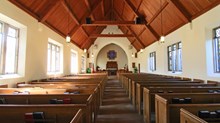Church after COVID—Why Bother Going Back?

It’s Sunday morning. I sit by the gas fireplace snuggled up in a warm blanket, relishing the quiet. Before long, the rest of the family will stir, and we’ll have a choice to make:
Get ready to go to church?
Livestream the service at home?
Watch it later?
Or skip it altogether?
Some of these options have emerged in 2020, thanks to the global pandemic. After 6 months of worship at home with church on Zoom or YouTube, rhythms that used to be automatic are no longer a given.
In our county of rural Alberta, Canada, we currently have zero cases of COVID19. Province-wide, K-12 students are back in class, and churches are allowed to meet again. Still, many precautions are in place. Attending church is more complicated now. Some churches require pre-registration, masks, and hand sanitizer. Most have chairs spaced apart or pews blocked off to ensure social distancing. Some won’t let you sing. Many have cancelled programming for children. And frankly, with no handshakes and no visiting in the lobby—in one door and out another—why bother going?
During the stay-at-home orders, many churches stepped up to the challenge of livestreaming services, investing in equipment and training to foster a sense of continuity. Churches that did this well are facing a new challenge: making the case to return to in-person services.
One rural pastor told me that his low-budget, inexperienced attempt at connecting digitally with his congregation has had a happy result: no one is clamoring for him to continue online services! They are all eager to come back to church. Another pastor told me that re-starting his church was proving harder than starting it in the first place.
Frankly, our church has done an excellent job of digitizing services, and our leaders have decided to continue livestreaming now that we’re meeting in person. This is partly for the sake of those who cannot yet safely gather because they are immuno-compromised, partly for those who are sick or in quarantine, partly to reach a wider audience beyond our small town, and partly because we can’t all fit into the building Sunday mornings with the chairs six feet apart.
Let me first say that if your state or county is prohibiting services, then by all means, stay home. Your government leaders are doing their best to keep you safe. This will not last forever. Eventually the restrictions will lift. When that day comes . . . why shatter the peace of the weekend by going through all of the COVID19 rigmarole, exchanging distant greetings, and singing muffled songs? Why not just tune in at home?
This pandemic has foisted an even bigger question on all of us—what is the point of church anyway? Can it be done online as well as in person? And if so, then why go back at all?
Depending on your church tradition, an obvious answer may present itself: communion. If you are Anglican, Episcopalian, Catholic, or Lutheran, you have gone without communion for 6 months or longer. Even for Baptists, crackers and juice at home are not quite the same. Likely, you feel the ache of its absence and you are eager to return. Communion is one important dimension of gathering for Christian worship that YouTube cannot replicate. It points toward a broader issue: embodiment.
Almost 500 years ago, the Heidelberg Catechism described the Christian experience in a way that anticipates our modern dilemma. It begins with a question: “What is your only comfort in life and death? I am not my own, but belong body and soul, both in life and in death, to my faithful Savior Jesus Christ” (Heidelberg Catechism, Question & Answer 1). My body belongs to Jesus. By extension, I also belong to his means of grace in the world, the church. Of course there is much more to being the church (and following Jesus) than attending a weekly service, but gathered worship is one significant aspect of being part of the church. When I choose not to attend, something is missing.
My absence diminishes what Christ can accomplish in and through the church, while my presence is a tangible means of participation in the kingdom. Ultimately, it’s not about “what I get out of it.” The church cannot fully accomplish her purposes in the world when I withhold my presence. Physical participation matters.
The writers of the Heidelberg Catechism could scarcely have anticipated the options we have to worship from home. Still, they insist that we belong to Jesus body and soul. They acknowledge the importance of embodied worship. Something happens when we are physically present together that is simply not possible when we log in online.
According to James K. A. Smith in his excellent book, You Are What You Love(Brazos, 2016), our physical participation has consequences that may be imperceptible now, but these add up to something significant. Our habitual acts shape our loves. Our loves shape who we become. Smith says that in order to cultivate virtue we must immerse ourselves in practices that inscribe them in our heart over time. He insists,
… counterformative Christian worship doesn’t just dispense information; rather, it is a Christ-centered imagination station where we regularly undergo a ritual cleansing of the symbolic universes we absorb elsewhere. Christian worship doesn’t just teach us how to think; it teaches us how to love, and it does so by inviting us into the biblical story and implanting that story in our bones (You Are What You Love, 85).
With this in mind, here are four reasons I am choosing to attend church in person again, now that it is allowed where I live:
1. Weekly fellowship in a church body orients my loves.
Each week my heart is re-calibrated in tiny ways that keep me facing Jesus rather than drifting in another direction. This is true even if I don’t feel particularly inspired or challenged on a given week. Church is not a vending machine, designed to meet my immediate needs. It is a field that, when cultivated year after year, will produce spiritual nourishment. The fact that I don’t walk out every Sunday with a full belly does not mean it is pointless to go. Little by little, week after week, I tend this field until it yields an abundant harvest.
2. Weekly fellowship in a church body reminds me that following Jesus means joining God's family.
When I signed on as a Christian, it was not a transaction designed primarily to secure my eternal destiny. Becoming a Christian means becoming part of God's family and changing how I live here and now. Spending week after week with these people, sharing this experience, eventually adds up to a network of caring relationships. It doesn’t happen overnight (remember, it’s a field, not a vending machine), but as we do life together, we lend support to each other on our faith journeys. Simply watching from home positions me as a solitary consumer rather than an active participant. While digital worship has been a gift to keep us connected during this strange season, it is not a sustainable way to cultivate the community of faith.
3. Weekly fellowship in a church body enables me to participate in God’s work of grace in others.
My effort to show up encourages my leaders, upholding their ministry. Any pastor who has tried preaching to a camera knows that it is not the same. My presence supports the work of my pastor and worship leader to study, plan, and prepare. It lends energy and solidarity to their message.
My presence also affirms the value of corporate worship for all those in attendance. My smile and my wave from six feet away and my voice lifted in praise (behind my pandemic mask) manifest the Spirit’s presence to others who have come. This is what it means to be the image of God. Our identity as God’s image is expressed physically—an embodied reminder of the presence and rule of God. We represent the unseen God to one another. I am not my own. I am a member of something bigger than myself—Christ’s body on earth. For those who have been isolated at home and traumatized by the incessant trials of this difficult year, my physical presence may be a lifeline. Caring eye contact may lend strength for another week.
4. Weekly fellowship in a church body is a means of declaring allegiance to the kingdom of God.
On the outside, the church may not seem like much. It may seem weak. But the church is a visible witness to the unseen reality of God’s kingdom. Being present each week testifies to this. It acknowledges that God’s invisible kingdom is more substantial and more lasting than the other concrete institutions in my community. It will outlast the postal service, local businesses, schools, and politicians and their offices. It will outlast the pandemic and the hurricanes and the wildfires and the ugly inequalities in our world. My participation ensures this. It testifies to that greater and lasting kingdom.
So, for these and other reasons, I go. I hope that as soon as you are able, you will go, too. Our circumstances may still be less than ideal, but the long-term benefits of embodied worship far outweigh the hassles. Whether I feel excited about it or not (and usually I do!), the church is my family, and I cannot be who I am meant to be without it.
Jesus Creed is a part of CT's
Blog Forum. Support the work of CT.
Subscribe and get one year free.
The views of the blogger do not necessarily reflect those of Christianity Today.




















